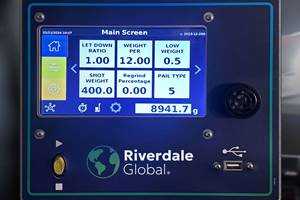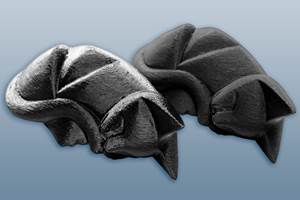Composites Show Introduces Reinforcements, Fillers and Additives
Pultrusion, filament winding, SMC, BMC, polymer concrete, and advanced composites are targets for new reinforcing fibers, fabrics, fillers, and other additives introduced at the recent Composites 2003 Show in Anaheim, Calif.
Pultrusion, filament winding, SMC, BMC, polymer concrete, and advanced composites are targets for new reinforcing fibers, fabrics, fillers, and other additives introduced at the recent Composites 2003 Show in Anaheim, Calif. The show was sponsored by the American Composites Manufacturers Association. We reported on new resins and initiators at the show last month.
Reinforcements & fillers
Fibertech Co. Ltd., which spins metal fibers for industrial filters, is exploring use of its 50-micron metal fibers as reinforcements in epoxy for aerospace applications. The fibers are available in copper, stainless steel, chrome-nickel alloy, and titanium.
Crane & Co.’s Nonwovens Div. says it is the first to offer fluoropolymer surfacing veils for high-temperature and chemical-resistant applications. The new products include Cranemat FH, made from Solvay’s Halar ECTFE fluoropolymer. Cranemat FM is made of Solvay’s Hyflon MFA fluoropolymer and can withstand heat up to 600 F.
Crane also recently introduced PPS nonwoven surfacing veils for use in high-temperature electronics, underground storage tanks, and other structures. Cranemat PPS is thermally stable up to 400 F. Nonwovens can also combine PPS and mineral fibers.
Directional Fabrics is a new company supplying uni- and multi-directional reinforcements of carbon, aramid, and glass for military and other applications. It also offers multiaxial Kevlar sheets with up to seven unidirectional layers. Special coatings are said to improve durability of the unidirectional plies.
Saint-Gobain Technical Fabrics introduced MultiCore, a cold-preformable fabric for closed molding that consists of chopped-strand glass mat stitched on both sides of a polypropylene-fiber batting. It comes either 3 or 5 mm thick, and the ratio of glass to PP can be varied as needed.
Sister company Saint-Gobain Vetrotex has improved its RO99-673 glass roving with new sizing that’s said to yield better mechanical properties in pultruded profiles. The roving itself has enhanced compression resistance, which reduces damage during shipping, stacking, and handling, thereby resulting in more consistent payout.
Also, SGV has a new glass reinforcement that boasts superior acid and alkaline resistance over the full pH range, even at high temperatures. ARcotex glass was originally developed for concrete reinforcement, but new sizing technology makes it suitable for chemical tanks, pipes, and fittings.
Spheretex America introduced the first roving form of its lightweight Sphere.tex E-glass reinforcement, which is impregnated with hollow thermoplastic microballoons for added bulk. The spray up roving, called Sphere.strand Guncore, is 50% lighter than standard E-glass roving and is aimed at lightweight, stiff parts or sandwich construction. Sphere.tex also comes in aramid and carbon-fiber forms.
Advanced Glassfiber Yarns introduced heavier weights of two high-strength glass rovings. Its VeTron, reportedly the only high-performance glass compatible with vinyl esters and polyesters, now comes in a 206-yard/lb yield as compared with the initial 413 yield launched a year earlier. Made of high-silica glass, VeTron costs about $5/lb, or five times as much as E-glass.
Single-end, epoxy-compatible ZenTron glass roving is now available in a 225 yield as well as the original 675 yield. ZenTron costs $6 to $7/lb.
New from Plascore Inc. is a prototype reinforcing honeycomb made of Kevlar-coated paper. It will be more expensive than Nomex-coated paper (made with a different DuPont aramid) but also will have greater strength. It is expected to become commercial early this year.
Composites One offers Kit Concepts, a new service that provides customized kits of fiberglass mats and fabrics precut to specified sizes and nested in the order needed for lay-up. The service is aimed at both open and closed molding, including RTM and closed-cavity bag molding (CCBM).
Siscor (Spherical Industrial Solutions Corp.) will soon manufacture in North America porous glass spheres that it previously imported from Poraver in Germany. Although porous and lightweight (9.36 to 33.07 pcf, depending on size), this filler does not absorb water. Siscor will produce a new smaller bead size of 0.05 to 0.125 mm designed especially for thermosets. The smallest grade used to be 0.1 to 0.3 mm. Made from recycled bottle glass, the beads are used in Europe for concrete filler. Composites are a new market.
More new additives
Byk-Chemie USA showed a new thixotropic additive that prevents fillers from settling or floating. In closed-mold applications, Byk P9055 reportedly can keep glass spheres from floating or separating by building a “pseudo-plastic network” through hydrogen bonding. It is geared to pultrusion, SMC, and BMC—but not room-temperature curing because it deactivates cobalt accelerator.
Avecia showed off two new additives—Solplus D 530, which improves talc dispersion, and Solplus TX5, a new anti-settling agent. Avecia is also developing new Solplus deaerating agents for polyesters and epoxies.
Rexco’s Marbalease is a new fast-drying liquid wax mold release designed specifically for polymer concrete in metal or polyester molds.
Related Content
Riverdale Global Showing Latest Innovations and New Satellite Location in Wisconsin
NPE2024: Live demos of updated RGS controller are among the highlights at its Wisconsin facility that will house the ‘new’ color R&D lab.
Read MoreMasterbatches Reduce Gloss in PLA and PETG 3D Printed Products
Insight Polymers & Compounding’s two low-gloss additive masterbatches shown to boost appearance of 3D printed objects.
Read MoreAdditives Boast Sustainability Without Sacrificing Performance
Sustainability continues to dominate new additives technology, but upping performance is also evident. Most of the new additives have been targeted to commodity resins and particularly polyolefins.
Read MoreSI Group Gets FDA Approval Extension for Weston 705 & 705T
SI’s phosphite antioxidants get ‘green light’ for use in PET food-contact packaging
Read MoreRead Next
Making the Circular Economy a Reality
Driven by brand owner demands and new worldwide legislation, the entire supply chain is working toward the shift to circularity, with some evidence the circular economy has already begun.
Read MorePeople 4.0 – How to Get Buy-In from Your Staff for Industry 4.0 Systems
Implementing a production monitoring system as the foundation of a ‘smart factory’ is about integrating people with new technology as much as it is about integrating machines and computers. Here are tips from a company that has gone through the process.
Read MoreSee Recyclers Close the Loop on Trade Show Production Scrap at NPE2024
A collaboration between show organizer PLASTICS, recycler CPR and size reduction experts WEIMA and Conair recovered and recycled all production scrap at NPE2024.
Read More












